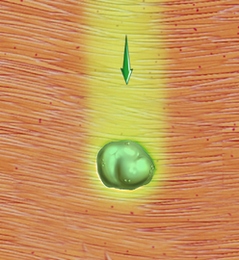Radiotherapy External – Radiatsionnaya therapy – Ionizing radiation
Description of external radiation therapy
Radiation therapy is one of the methods of treating cancer and other diseases. It uses high-energy particles, that damage the genetic code (DNA) in cancer cells. After radiation exposure the cells are unable to grow and divide.
There are two main types of radiation therapy:
- External radiation therapy – exposure is performed using the apparatus, located outside the body;
- Internal radiation therapy – radioactive materials placed directly into a cancerous tumor in the body (also called brachytherapy);
In some cases, your doctor may recommend a combination of treatments. Radiation therapy is often used with other treatments, such as surgery, chemotherapy and immunotherapy (It stimulates the immune system to fight infection).
Reasons for treatment using external beam radiation therapy
- Control the growth or spread of cancer;
- Trying to cure cancer;
- Relieve pain or other symptoms, caused by cancer (this is called palliative treatment).
Radiotherapy is widely used to treat:
- Solid tumors, such as prostate cancer, breast cancer, and head and neck cancer;
- Lymphomas and leukemias.
Possible complications of external radiation therapy
External radiation does not cause the body radioactivity. The method of treatment can cause side effects, since the radiation damage healthy cells in conjunction with cancer. Common side effects include radiation exposure, Besides, may:
- Fatigue;
- Skin changes (redness, irritation);
- Reduced number of leukocytes in the blood;
- Hair loss;
- Nausea, vomiting, or diarrhea;
- Loss of appetite.
Discuss the specific side effects can be a doctor.
Factors, that may increase the risk of complications:
- Previous radiation therapy;
- History erythematosus, scleroderma or dermatomyositis.
Women, who are pregnant or may be pregnant should avoid using external radiation therapy. It may harm the developing fetus.
How is the external radiation therapy?
Preparation for the procedure
Preparing for radiation called modeling. The procedure takes from 30 minutes to two hours.
- You will lie on an exam table. The therapist uses computed tomography, to determine the exact location, which will be directed radiation. It may be noted the exact spot on the skin color ink or marker. Also, the skin can be made small tattoo (or more), to help guide the radiation beam.
- Depending on the type of treatment may need to install different devices, help treatment.
Procedure external radiation therapy
You will be placed on the treatment table or chair. The doctor left the room to the control room. The device starts up and irradiates abnormal areas of the body. The most common sources of radiation are X-rays, electron beams, and cobalt-60.
You must lie still during treatment. The therapist can see you on the screen and communicate via intercom. We need to tell him, if during irradiation there pain or discomfort.

How long will the external radiotherapy?
Irradiation takes 1-5 minutes. For one course of treatment to get the total amount 30 minutes of irradiation. Most procedures take 2-8 weeks. They are held once a day, five days a week. In some cases, the irradiation should be performed twice a day or three times a week. Treatment schedule will depend on many factors. The planned schedule of radiation can be found at the oncologist.
Will it hurt when irradiated?
No, procedure bezboleznenna.
The average time of stay in the hospital after external beam radiotherapy
The procedure is performed on an outpatient basis and does not require a hospital stay.
Care after external beam radiotherapy
Be sure to follow your doctor's instructions.
After the procedure, you can resume normal activities, because they are not a threat to others in terms of radiation exposure.
During treatment you should visit the doctor at least once a week. It is necessary to perform routine blood tests to check the effects of radiation on the blood cells.
After completion of treatment you will need to visit the hospital to assess the effectiveness of treatment. Care may include further testing, medications or medical rehabilitation.
Tell your doctor, if you have any side effects. Many side effects can be treated with medication or diet. Your doctor may change or delay the course of treatment, if the side effects are too much or they pose a threat to life. Most of the side effects wear off after treatment.
Contact your doctor after external beam radiotherapy
After returning home, you need to see a doctor, If the following symptoms:
- Signs of infection, including fever and chills;
- Diarrhea or loss of appetite;
- Unexplained weight loss;
- Frequent urination, especially if it is associated with pain and burning;
- New or unusual swelling or tumors;
- Nausea and / or vomiting, that do not pass after taking the prescribed medicines;
- Pain, which does not pass;
- Unusual changes in the skin, including bruising, rash, discharge or bleeding;
- Cough, shortness of breath or chest pain;
- Any other painful symptoms.
